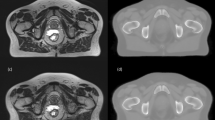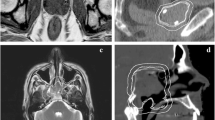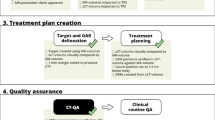Abstract
The introduction of MRI linear accelerators (MR-linacs) and the increased use of MR imaging in radiotherapy, requires improved approaches to MRI-only radiotherapy. MRI provides excellent soft tissue visualisation but does not provide any electron density information required for radiotherapy dose calculation, instead MRI is registered to CT images to enable dose calculations. MRI-only radiotherapy eliminates registration errors and reduces patient discomfort, workload and cost. Electron density requirements may be addressed in different ways, from manually applying bulk density corrections, to more computationally intensive methods to produce substitute CT datasets (sCT), requiring additional sequences, increasing overall imaging time. Reducing MR imaging time would reduce potential artefacts from intrafraction motion and patient discomfort. The aim of this study was to assess the impact of reducing MR imaging time on a hybrid atlas-voxel sCT conversion for prostate MRI-only treatment planning, considering both anatomical and dosimetric parameters. 10 volunteers were scanned on a Siemens Skyra 3T MRI. Sequences included the 3D T2-weighted (T2-w) SPACE sequence used for sCT conversion as previously validated against CT, along with variations to this sequence in repetition time (TR), turbo factor, and combinations of these to reduce the imaging time. All scans were converted to sCT and were compared to the sCT from the original SPACE sequence, evaluating for anatomical changes and dosimetric differences for a standard prostate VMAT plan. Compared to the previously validated T2-w SPACE sequence, scan times were reduced by up to 80%. The external volume and bony anatomy were compared, with all but one sequence meeting a DICE coefficient of 0.9 or better, with the largest variations occurring at the edges of the external body volume. The generated sCT agreed with the gold standard sCT within an isocentre dose of 1% and a gamma pass rate of 99% for a 1%/1 mm gamma tolerance for all but one sequence. This study demonstrates that the MR imaging sequence time was able to be reduced by approximately 80% with similar dosimetric results.



Similar content being viewed by others
Data availability
Due to the nature of this research, participants of this study did not agree for their data to be shared publicly, so supporting data is not available.
References
Nyholm T, Jonsson J (2014) Counterpoint: opportunities and challenges of a magnetic resonance imaging-only radiotherapy work flow. Semin Radiat Oncol 24(3):175–180. https://doi.org/10.1016/j.semradonc.2014.02.005
Owrangi AM, Greer PB, Glide-Hurst CK (2018) MRI-only treatment planning: benefits and challenges. Phys Med Biol 63(5):05TR01
Stanescu T, Kirkby C, Wachowicz K, Fallone BG (2009) Developments in MRI-based radiation treatment planning. In: Dössel O, Schlegel W (eds) World congress on medical physics and biomedical engineering, September 7–12, 2009, Munich, Germany, IFMBE Proceedings, vol. 25/1. Springer, Berlin, pp 821–824, https://doi.org/10.1007/978-3-642-03474-9_231
Johansson A, Karlsson M, Nyholm T, (2011) CT substitute derived from MRI sequences with ultrashort echo time. Med Phys. https://doi.org/10.1118/1.3578928
Karotki A, Mah K, Meijer G, Meltsner M (2011) Comparison of bulk electron density and voxel-based electron density treatment planning. J Appl Clin Med Phys 12(4):97–104
Dowling JA, Lambert J, Parker J, Salvado O, Fripp J, Capp A, Wratten C, Denham JW, Greer PB (2012) An atlas-based electron density mapping method for magnetic resonance imaging (MRI)-alone treatment planning and adaptive MRI-based prostate radiation therapy. Int J Radiat Oncol*Biol*Phys 83(1):e5–e11. https://doi.org/10.1016/j.ijrobp.2011.11.056
Greer PB, Martin J, Sidhom M, Hunter P, Pichler P, Choi JH, Best L, Smart J, Young T, Jameson M (2019) A multi-center prospective study for implementation of an MRI-only prostate treatment planning workflow. Front Oncol 9:826
Chen L, Price R Jr, Nguyen T, Wang L, Li J, Qin L, Ding M, Palacio E, Ma C, Pollack A (2004) Dosimetric evaluation of MRI-based treatment planning for prostate cancer. Phys Med Biol 49(22):5157
Korhonen J, Kapanen M, Keyriläinen J, Seppälä T, Tuomikoski L, Tenhunen M (2013) Absorbed doses behind bones with MR image-based dose calculations for radiotherapy treatment planning. Med Phys 40(1):011701. https://doi.org/10.1118/1.4769407
Kapanen M, Collan J, Beule A, Seppälä T, Saarilahti K, Tenhunen M (2013) Commissioning of MRI-only based treatment planning procedure for external beam radiotherapy of prostate. Magn Reson Med 70(1):127–135
Jonsson JH, Karlsson MG, Karlsson M, Nyholm T (2010) Treatment planning using MRI data: an analysis of the dose calculation accuracy for different treatment regions. Radiat Oncol (London, England) 5:62–62. https://doi.org/10.1186/1748-717X-5-62
Karlsson M, Karlsson MG, Nyholm T, Amies C, Zackrisson B (2009) Dedicated magnetic resonance imaging in the radiotherapy clinic. Int J Radiat Oncol*Biol*Phys 74(2):644–651. https://doi.org/10.1016/j.ijrobp.2009.01.065
Roberson PL, McLaughlin PW, Narayana V, Troyer S, Hixson GV, Kessler ML (2005) Use and uncertainties of mutual information for computed tomography/magnetic resonance (CT/MR) registration post permanent implant of the prostate. Med Phys 32(2):473–482. https://doi.org/10.1118/1.1851920
Jonsson J, Nyholm T, Söderkvist K (2019) The rationale for MR-only treatment planning for external radiotherapy. Clin Transl Radiat Oncol 18:60–65. https://doi.org/10.1016/j.ctro.2019.03.005
Edmund JM, Nyholm T (2017) A review of substitute CT generation for MRI-only radiation therapy. Radiat Oncol 12(1):28
Johnstone E, Wyatt JJ, Henry AM, Short SC, Sebag-Montefiore D, Murray L, Kelly CG, McCallum HM, Speight R (2018) Systematic review of synthetic computed tomography generation methodologies for use in magnetic resonance imaging–only radiation therapy. Int J Radiat Oncol*Biol*Phys 100(1):199–217
Han X (2017) MR-based synthetic CT generation using a deep convolutional neural network method. Med Phys 44(4):1408–1419
Liney GP, Moerland MA (2014) Magnetic resonance imaging acquisition techniques for radiotherapy planning. Semin Radiat Oncol 24(3):160–168. https://doi.org/10.1016/j.semradonc.2014.02.014
Mekle R, Wu EX, Meckel S, Wetzel SG, Scheffler K (2006) Combo acquisitions: balancing scan time reduction and image quality. Magn Reson Med 55(5):1093–1105
Prior P, Chen X, Botros M, Paulson ES, Lawton C, Erickson B, Li XA (2016) MRI-based IMRT planning for MR-linac: comparison between CT-and MRI-based plans for pancreatic and prostate cancers. Phys Med Biol 61(10):3819
Feinberg DA, Hale JD, Watts JC, Kaufman L, Mark A (1986) Halving MR imaging time by conjugation: demonstration at 3.5 kG. Radiology 161(2):527–531. https://doi.org/10.1148/radiology.161.2.3763926
McRobbie DW, Moore EA, Graves MJ, Prince MR (2017) MRI from picture to proton. Cambridge University Press, Cambridge
Hennig J, Nauerth A, Friedburg H (1986) RARE imaging: a fast imaging method for clinical MR. Magn Reson Med 3(6):823–833
Hennig J, Friedburg H (1988) Clinical applications and methodological developments of the RARE technique. Magn Reson Imaging 6(4):391–395. https://doi.org/10.1016/0730-725X(88)90475-4
Constable RT, Anderson AW, Zhong J, Gore JC (1992) Factors influencing contrast in fast spin-echo MR imaging. Magn Reson Imaging 10(4):497–511. https://doi.org/10.1016/0730-725X(92)90001-G
Jones KM, Mulkern R, Schwartz RB, Oshio K, Barnes PD, Jolesz F (1992) Fast spin-echo MR imaging of the brain and spine: current concepts. AJR Am J Roentgenol 158(6):1313–1320
Hollingsworth KG (2015) Reducing acquisition time in clinical MRI by data undersampling and compressed sensing reconstruction. Phys Med Biol 60(21):R297–R322. https://doi.org/10.1088/0031-9155/60/21/r297
Griswold MA, Jakob PM, Heidemann RM, Nittka M, Jellus V, Wang J, Kiefer B, Haase A (2002) Generalized autocalibrating partially parallel acquisitions (GRAPPA). Magn Reson Med 47(6):1202–1210. https://doi.org/10.1002/mrm.10171
Dowling JA, Sun J, Pichler P, Rivest-Hénault D, Ghose S, Richardson H, Wratten C, Martin J, Arm J, Best L (2015) Automatic substitute computed tomography generation and contouring for magnetic resonance imaging (MRI)-alone external beam radiation therapy from standard MRI sequences. Int J Radiat Oncol*Biol*Phys 93(5):1144–1153
Mugler JP III (2014) Optimized three-dimensional fast-spin-echo MRI. J Magn Reson Imaging 39(4):745–767. https://doi.org/10.1002/jmri.24542
Farjam R, Tyagi N, Deasy JO, Hunt MA (2019) Dosimetric evaluation of an atlas-based synthetic CT generation approach for MR-only radiotherapy of pelvis anatomy. J Appl Clin Med Phys 20(1):101–109
Christiansen RL, Jensen HR, Brink C (2017) Magnetic resonance only workflow and validation of dose calculations for radiotherapy of prostate cancer. Acta Oncol 56(6):787–791
Tyagi N, Fontenla S, Zhang J, Cloutier M, Kadbi M, Mechalakos J, Zelefsky M, Deasy J, Hunt M (2017) Dosimetric and workflow evaluation of first commercial synthetic CT software for clinical use in pelvis. Phys Med Biol 62(8):2961
Persson E, Jamtheim Gustafsson C, Ambolt P, Engelholm S, Ceberg S, Bäck S, Olsson LE, Gunnlaugsson A (2020) MR-PROTECT: clinical feasibility of a prostate MRI-only radiotherapy treatment workflow and investigation of acceptance criteria. Radiat Oncol 15:1–13
Persson E, Gustafsson C, Nordström F, Sohlin M, Gunnlaugsson A, Petruson K, Rintelä N, Hed K, Blomqvist L, Zackrisson B (2017) MR-OPERA: a multicenter/multivendor validation of magnetic resonance Imaging-Only prostate treatment planning using synthetic computed tomography images. Int J Radiat Oncol*Biol*Phys 99(3):692–700
Siversson C, Nordström F, Nilsson T, Nyholm T, Jonsson J, Gunnlaugsson A, Olsson LE (2015) Technical note: MRI only prostate radiotherapy planning using the statistical decomposition algorithm. Med Phys 42(10):6090–6097. https://doi.org/10.1118/1.4931417
Author information
Authors and Affiliations
Contributions
TY: conceived and designed the analysis, collected the data, contributed data or analysis tools, performed the analysis, wrote the paper. JD: contributed data or analysis tools, manuscript review. RR: conceived and designed the analysis, collected the data, manuscript review. GL: conceived and designed the analysis. PG, DT, LH: conceived and designed the analysis, manuscript review.
Corresponding author
Ethics declarations
Conflict of interest
Authors declare no conflicts of interest.
Consent to participate
Informed consent was obtained from all individual participants included in the study.
Consent to publish
The authors affirm that human research participants provided informed consent for publication of data.
Research involving humans and animal rights
Volunteer data obtained for this study was acquired with local ethics committee approval (HREC/15/LPOOL/506).
Additional information
Publisher's Note
Springer Nature remains neutral with regard to jurisdictional claims in published maps and institutional affiliations.
Rights and permissions
About this article
Cite this article
Young, T., Dowling, J., Rai, R. et al. Effects of MR imaging time reduction on substitute CT generation for prostate MRI-only treatment planning. Phys Eng Sci Med 44, 799–807 (2021). https://doi.org/10.1007/s13246-021-01031-0
Received:
Accepted:
Published:
Issue Date:
DOI: https://doi.org/10.1007/s13246-021-01031-0




